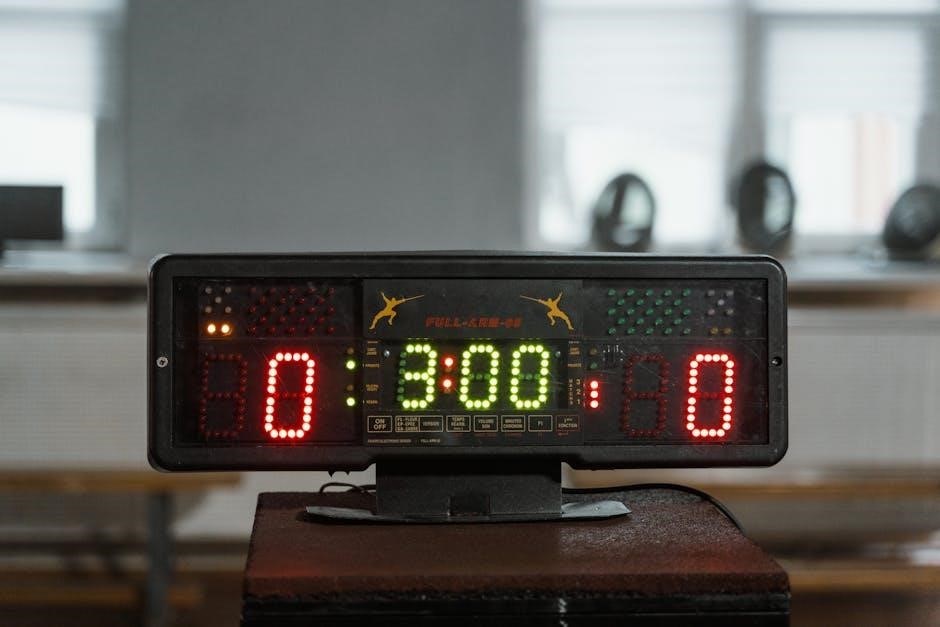electronic 7 day timer instructions
An electronic 7-day timer is a programmable device that automates appliance operation over a week; It offers precise scheduling, energy efficiency, and convenience for modern households.
1.1 What is an Electronic 7-Day Timer?
An electronic 7-day timer is a programmable device that allows users to schedule appliance operation for each day of the week. It provides precise control over on/off times, enabling energy efficiency and convenience. Designed for home automation, it is user-friendly and compatible with various devices, making it ideal for managing lights, heaters, and other household appliances seamlessly.
1.2 Importance of Using a 7-Day Timer
A 7-day timer enhances energy efficiency by automating appliance operation, reducing manual oversight. It minimizes energy waste and lowers utility bills through precise scheduling. Ideal for busy households, it offers convenience and consistency, ensuring devices operate only when needed. This device is particularly beneficial for managing storage heaters and optimizing Economy 7 tariffs, making it a practical solution for modern, energy-conscious homes.
Features and Benefits
Electronic 7-day timers offer programmable scheduling, energy efficiency, and compatibility with various appliances. They provide consistent operation, reducing manual effort and optimizing energy usage for households and businesses.
2.1 Key Features to Look For
When selecting an electronic 7-day timer, look for programmable scheduling, digital display, and compatibility with your appliances. Ensure it supports multiple on/off cycles and has battery backup for power outages. Wi-Fi connectivity for smart home integration and energy monitoring features are also valuable. A user-friendly interface and clear instructions enhance ease of use. Additionally, check for compatibility with Economy 7 tariffs if applicable, and ensure it supports storage heaters for efficient energy management.
2.2 Benefits of a 7-Day Timer
A 7-day timer offers enhanced energy efficiency by optimizing appliance usage. It provides convenience through automated scheduling, reducing manual effort. Customizable settings allow precise control of on/off times, aligning with your daily routine. Additionally, it supports Economy 7 tariffs, helping you save on energy costs. The timer also enhances home security by simulating occupancy and reduces energy waste, making it a smart investment for modern households.
Installation and Setup
Begin by unpacking and understanding the timer’s components. Check compatibility with your system, then mount the timer in an accessible location. Connect it securely to the power supply and test functionality before finalizing the setup.
3.1 Initial Setup and Compatibility Check
Start by unpacking the timer and ensuring all components are included. Verify compatibility with your electrical system and appliances. Check voltage requirements and wiring specifications to avoid any mismatches. Perform a quick power-on test to ensure the display lights up and functions correctly. This step ensures smooth installation and prevents potential issues down the line.
3.2 Mounting and Connecting the Timer
Mount the timer near the appliance, ensuring easy access. Follow the wiring diagram to connect the timer to your electrical circuit. Secure all connections tightly and double-check for proper polarity. Test the timer by switching it on and off to confirm functionality. Ensure all safety precautions are followed to avoid electrical hazards. This step ensures reliable operation and integrates the timer seamlessly with your appliance.
Programming the Timer
Programming the timer involves setting the clock, creating custom schedules, and editing or deleting existing ones to automate appliance control and optimize energy usage efficiently.
4.1 Setting the Clock and Days
To begin, set the current time accurately on the timer. Ensure the time format matches your preference, such as 12-hour or 24-hour. Next, select the active days for your schedule by choosing specific days of the week or setting it to run every day. Most timers allow you to toggle between days using buttons or a touchscreen. Confirm your settings to avoid errors. This step ensures your timer operates on the correct schedule and days, providing reliable automation for your appliances.
4.2 Creating Custom Schedules
Start by selecting the desired time and day for your appliance to activate. Use the timer’s interface to set specific on/off times for each day or group of days. For example, you can program the timer to turn on at 7:00 AM and off at 9:00 PM, Monday through Friday. If needed, create multiple events within a single day. Ensure to save your custom schedule to apply the settings effectively.
4.3 Editing or Deleting Schedules
To edit a schedule, access the timer’s menu, select the event you wish to modify, and adjust the time or day as needed. If a schedule is no longer required, navigate to the event and choose the delete option. Ensure to save changes after editing or deleting to apply them. This feature allows for flexibility and ensures your timer remains efficient and aligned with your needs.

Advanced Features
Electronic 7-day timers offer advanced features like Economy 7 compatibility, storage heater control, smart home integration, and energy usage monitoring for enhanced efficiency and convenience.
5.1 Understanding Economy 7 Tariff Compatibility
Economy 7 tariffs offer cheaper electricity during off-peak hours, typically overnight. Electronic 7-day timers can be programmed to utilize this period, optimizing energy costs. They are designed to work seamlessly with Economy 7, ensuring appliances like storage heaters operate efficiently during low-rate times, helping users save money without compromising comfort or convenience.
5.2 Using the Timer with Storage Heaters
Electronic 7-day timers are ideal for controlling storage heaters, which rely on Economy 7 tariffs for efficient operation. By programming the timer, you can ensure heaters charge during off-peak hours, providing consistent warmth throughout the day. This setup maximizes energy efficiency and cost savings, making it a practical solution for households using storage heating systems.
Troubleshooting Common Issues
Troubleshooting electronic 7-day timers involves identifying and resolving issues like power failures or scheduling errors. Regular checks ensure optimal performance and extend the timer’s lifespan.
6.1 Timer Not Turning On
If the timer fails to turn on, first ensure it is properly plugged into a functioning outlet. Check for any visible damage to the power cord or plug. Verify that the circuit breaker hasn’t tripped. If using a battery backup, replace the batteries with fresh ones. Ensure the display settings are correct, such as brightness levels. If issues persist, consult the user manual or contact customer support for assistance.
6.2 Schedules Not Working Correctly
If schedules aren’t functioning as expected, check the timer’s clock and ensure it’s set correctly. Verify that the days of the week are properly selected. Review the programmed times and ensure they’re accurate. Restart the timer and test a simple schedule. If issues persist, reset the timer to factory settings and reprogram it. Ensure there are no software or firmware updates needed for optimal performance.

Maintenance and Care
Regularly clean the timer with a soft cloth and avoid harsh chemicals. Check batteries or power connections monthly. Store backups of schedules to prevent data loss.
7.1 Cleaning the Timer
Regular cleaning ensures optimal performance. Use a soft, dry microfiber cloth to wipe the timer’s surface. Avoid harsh chemicals or liquids, as they may damage the display or internal components. For stubborn marks, lightly dampen the cloth with distilled water. Always turn off the timer before cleaning. Gently remove dust buildup from vents or buttons to maintain proper airflow and functionality. This simple routine keeps your timer functioning like new and prevents mechanical issues.
7.2 Replacing Batteries
To replace the timer’s batteries, first power it off. Open the battery compartment, usually located on the back or bottom. Remove the old batteries and insert replacements of the same type (e.g., AA or lithium). Ensure proper orientation to match the polarity indicators. Close the compartment securely. If the timer has a memory function, it will retain settings. For optimal performance, use high-quality batteries and avoid mixing old and new ones. Regular replacement prevents power-related issues.
Safety Considerations
Ensure proper electrical connections and avoid overload to prevent fire hazards. Keep the timer away from flammable materials and follow manufacturer guidelines for safe operation and installation.
8.1 Electrical Safety Precautions
Always follow electrical safety guidelines to avoid hazards. Ensure proper installation, avoid overloading circuits, and use the correct voltage rating. Keep the timer dry and away from water sources. Never modify the device or tamper with internal components. If unsure, consult a licensed electrician. Regularly inspect cords and connections for damage. Turn off power before making adjustments to prevent shocks or electrical fires.
8.2 Fire Hazards and Prevention
Electronic 7-day timers can pose fire risks if not used correctly. Ensure proper ventilation to prevent overheating. Avoid placing timers near flammable materials or heat sources. Never use damaged cords or overloaded circuits. Regularly inspect for worn-out components and replace them promptly. Follow manufacturer guidelines for installation and operation. Keep timers away from water to prevent electrical fires. Install smoke detectors for early fire detection and ensure a fire extinguisher is nearby.

Integration with Smart Home Systems
Electronic 7-day timers can integrate with smart home systems via Wi-Fi or Zigbee, enabling remote control through apps and voice assistants like Alexa or Google Home.
9.1 Compatibility with Smart Devices
Modern electronic 7-day timers are designed to integrate seamlessly with various smart devices. They often support popular protocols like Zigbee and Wi-Fi, allowing connection to hubs such as SmartThings or Apple HomeKit. This compatibility ensures that users can control their timers through smartphone apps or voice assistants like Amazon Alexa or Google Assistant, enhancing convenience and home automation capabilities significantly.
9.2 Remote Access and Control
Electronic 7-day timers often feature remote access capabilities, allowing users to adjust settings and monitor schedules via smartphone apps. This functionality, typically enabled through Wi-Fi or internet connectivity, provides unparalleled convenience. Users can modify timers, receive notifications, and maintain control over their devices from anywhere. Remote access enhances flexibility and ensures seamless management of automated schedules, even when away from home.

Energy Efficiency and Savings
Electronic 7-day timers enhance energy efficiency by automating schedules, optimizing appliance operation, and reducing waste. They offer significant cost savings and environmental benefits over time.
10.1 How 7-Day Timers Contribute to Energy Efficiency
Electronic 7-day timers boost energy efficiency by allowing precise control over appliance operation. They ensure devices run only when needed, preventing standby power waste and optimizing energy use. By automating schedules, these timers align with off-peak tariffs, reducing consumption during high-demand periods; This leads to lower utility bills and a smaller carbon footprint, making them a smart choice for eco-conscious users.
10.2 Maximizing Savings with Economy 7
Electronic 7-day timers enhance savings with Economy 7 by automating appliance usage during off-peak hours. By programming schedules to align with Economy 7 tariffs, users can significantly reduce energy bills. The timer ensures appliances like storage heaters operate efficiently, utilizing cheaper nighttime electricity. This optimization not only cuts costs but also promotes energy-efficient habits, making it a practical solution for households seeking financial and environmental benefits.
Electronic 7-day timers offer a practical, energy-efficient solution for managing appliances. Their programmability ensures convenience and cost savings, making them a valuable addition to modern households.
11;1 Summing Up the Benefits
Electronic 7-day timers provide precise control over appliance operation, optimizing energy use and reducing waste. Their programmable nature ensures convenience and consistency, while compatibility with smart systems enhances functionality. By automating tasks, these timers save time and effort, offering a practical solution for modern households. They also promote energy efficiency, contributing to cost savings and environmental benefits, making them a valuable investment for any home.
11.2 Final Tips for Optimal Use
Regularly clean and maintain your timer to ensure accuracy. Schedule tasks in advance to avoid missed cycles. Test compatibility with smart devices for seamless integration. Always backup settings before updating or resetting. Review and adjust schedules seasonally to align with lifestyle changes. Properly replace batteries to prevent data loss. By following these tips, you can maximize efficiency and enjoy hassle-free operation of your electronic 7-day timer.
